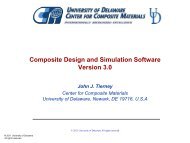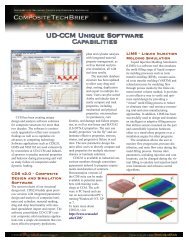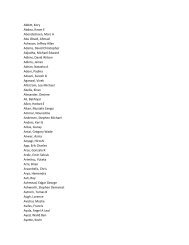Dynamic properties of shear thickening colloidal suspensions
Dynamic properties of shear thickening colloidal suspensions
Dynamic properties of shear thickening colloidal suspensions
Create successful ePaper yourself
Turn your PDF publications into a flip-book with our unique Google optimized e-Paper software.
200<br />
determining the time scales required to generate the<br />
<strong>shear</strong> <strong>thickening</strong> response. Of interest for technological<br />
applications is the time scale and the minimum strain<br />
required to generate the hydrocluster microstructure<br />
underlying the <strong>shear</strong> <strong>thickening</strong> response. For example,<br />
electrostatically stabilized dispersions have been investigated<br />
in both steady and dynamic oscillatory <strong>shear</strong><br />
flows for possible damping applications. Laun et al.<br />
(1991) reported the dynamic strain hardening behavior<br />
<strong>of</strong> a polymer latex dispersion. Their oscillatory test<br />
protocol increased the strain amplitude at a given frequency,<br />
which leads to a <strong>shear</strong> <strong>thickening</strong> rheology.<br />
The critical strain for dynamic <strong>shear</strong> <strong>thickening</strong> (cc) was observed to decrease with increasing frequency<br />
(x), but eventually plateaued at higher frequencies.<br />
The low frequency behavior was interpreted in terms<br />
<strong>of</strong> the steady <strong>shear</strong> behavior, where a critical <strong>shear</strong> rate<br />
( _c dynamic<br />
c _c steady<br />
c ) must be achieved to thicken. The high<br />
frequency limiting value suggested that a minimum<br />
<strong>shear</strong> strain ( 50%) is necessary in each half cycle to<br />
cause the dispersion to switch to the high viscosity state.<br />
Similar conclusions for low frequencies were reached by<br />
Boersma et al. (1992), who investigated monodisperse<br />
silica particles suspended in a mixture <strong>of</strong> glycerol and<br />
water. They reported ‘‘flow blockage’’ in oscillatory<br />
testing, which was also related to steady <strong>shear</strong> <strong>thickening</strong><br />
at low frequencies. Intermediate frequencies yielded a<br />
weaker frequency dependence, but no plateau value.<br />
Finally, at high frequencies the critical deformation for<br />
<strong>shear</strong> <strong>thickening</strong> was found to be independent <strong>of</strong> particle<br />
volume fraction, but again scaled inversely with<br />
frequency. This latter behavior was attributed to the<br />
solid-like response for a sample that is fully in the<br />
hydrocluster state. Note that these experiments were<br />
also performed on a controlled strain rheometer and<br />
the critical strain amplitudes were <strong>of</strong> order O(10 -2 ) at the<br />
highest frequencies.<br />
Studies <strong>of</strong> near hard sphere dispersions (Bender<br />
1995) also confirm the agreement between steady <strong>shear</strong><br />
<strong>thickening</strong> and the low frequency dynamic oscillatory<br />
response. Raghavan and Khan (1997) observed similar<br />
congruence at low frequencies, as well as a high frequency<br />
limiting critical strain (cc O(1)) for fumed silica<br />
dispersions in poly(propylene glycol). Recently,<br />
Mewis and Biebaut (2001) also observed dynamic<br />
<strong>shear</strong> <strong>thickening</strong> in sterically stabilized <strong>colloidal</strong> <strong>suspensions</strong>.<br />
They observed that the peak <strong>shear</strong> stress at<br />
the onset <strong>of</strong> <strong>shear</strong> <strong>thickening</strong> in oscillatory flow corresponds<br />
to the same steady <strong>shear</strong> stress measured at<br />
the onset <strong>of</strong> <strong>shear</strong> <strong>thickening</strong>, with no evidence <strong>of</strong> a<br />
limiting critical strain down to <strong>shear</strong> strains <strong>of</strong> order<br />
0.5. Notably, Mewis and Biebaut (2001) also investigated<br />
the <strong>shear</strong> thickened state by parallel superposition,<br />
observing a viscoelastic liquid response in the<br />
<strong>shear</strong> thickened state, not the solid response suggested<br />
by Boersma et al. (1992).<br />
In summary, the literature data to date suggests that<br />
the onset <strong>of</strong> strain hardening at low frequencies for<br />
concentrated <strong>suspensions</strong> in oscillatory <strong>shear</strong> flow can<br />
be interpreted in terms <strong>of</strong> the onset <strong>of</strong> steady <strong>shear</strong><br />
<strong>thickening</strong>. However, there is contradictory evidence as<br />
to whether a critical strain is required for oscillatory<br />
strain hardening, and as to whether a third, solid-like<br />
regime exists at higher frequencies. This issue is relevant<br />
for the design <strong>of</strong> devices based on the <strong>shear</strong><br />
<strong>thickening</strong> response (Helber et al. 1990). The goal <strong>of</strong><br />
this work is to relate the nonlinear viscoelastic <strong>properties</strong><br />
to the steady <strong>shear</strong> response for a <strong>shear</strong> <strong>thickening</strong><br />
fluid, and to determine if a minimum critical<br />
strain is necessary for <strong>shear</strong> <strong>thickening</strong>. This is achieved<br />
by rheological investigation <strong>of</strong> a model dispersion. Of<br />
particular interest is the critical strain amplitude required<br />
for <strong>shear</strong> <strong>thickening</strong> in dynamic <strong>shear</strong> flow and<br />
its dependence on frequency. Finally, Lissajous plots<br />
are constructed to illustrate the ‘‘switching’’ from liquid<br />
to solid observed during deformation, and to determine<br />
the energy dissipation’s depend on strain amplitude in<br />
a <strong>shear</strong> <strong>thickening</strong> fluid.<br />
Experimental<br />
Sample preparation and characterization The <strong>colloidal</strong> silica investigated<br />
here was obtained from Nissan Chemicals (MP4540), which<br />
is provided as an aqueous suspension (pH=8.5 at 25 °C) with a<br />
particle concentration <strong>of</strong> about 40 wt%. The particle size distribution<br />
has been characterized with dynamic light scattering and<br />
TEM. Figure 1 shows a transmission electron micrograph <strong>of</strong> the<br />
suspension; which is observed to contain a minor fraction <strong>of</strong><br />
smaller particles. The average particle diameter (z-average) was<br />
determined to be 446±8.4 nm by dynamic light scattering, which<br />
agrees with the TEM measurements <strong>of</strong> the large particle fractions.<br />
The solution density <strong>of</strong> the particles has been obtained by measuring<br />
the density <strong>of</strong> the suspension as a function <strong>of</strong> weight fraction<br />
<strong>of</strong> the particles. The weight fraction <strong>of</strong> silica was determined<br />
gravimetrically after drying the sample at 180 °C for 5 h using a<br />
convection oven. The density <strong>of</strong> the silica calculated from this<br />
method is 1.78 g/cc. The zeta potential has been determined to be<br />
)32 mV from electrophoresis measurements (Brookhaven Zeta-<br />
PALS) at pH=8.5 and CSALT=0.045 mmol/l. This suspension was<br />
concentrated by tabletop centrifugation. The sediment was resuspended<br />
using a vortex mixer after adding <strong>of</strong> small amount <strong>of</strong> the<br />
supernatant liquid. Dilution with the mother liquor provided a<br />
series <strong>of</strong> aqueous silica <strong>suspensions</strong>. The suspending fluid was also<br />
replaced with ethylene glycol (EG) by repeated centrifugation and<br />
resuspension with a vortex mixer. This process has been repeated<br />
four times to prepare a second series <strong>of</strong> dispersions <strong>of</strong> the same<br />
particles in ethylene glycol.<br />
Rheological measurements The experiments were performed primarily<br />
in a stress-controlled rheometer (SR-500, Rheometrics) at<br />
25 °C with cone-plate geometry having a cone angle <strong>of</strong> 0.1 radian<br />
and a diameter <strong>of</strong> 25 mm. Complementary measurements were<br />
performed on a Rheometrics ARES controlled strain rheometer. A<br />
parallel plate geometry was also used with varying gap size to<br />
characterize slip. To prevent adhesive slip between the sample and<br />
the rheometer plates, parallel plates <strong>of</strong> diameter 25 mm were covered<br />
with emery cloth (NORTON, E-Z FLEX METALITE K224)<br />
using double stick tape. The gaps explored varied between 0.05 mm






